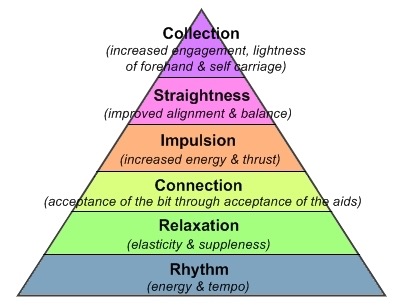Training horses for success in a variety of disciplines calls for an intelligent and thorough approach to their upbringing. Over thousands of years, horse trainers have created numerous systematic approaches in order to develop a horse to the best of their abilities.
One of the most well-known and respected of these is the German Training Scale, or “training pyramid.” It is a staple in the dressage discipline but can be utilized by any trainer to correctly and comprehensively develop a horse into a competitive athlete. Developed by German classical trainers and based on military training practices followed hundreds of year ago, this pyramid serves as a template for trainers to follow as they progress through the levels of Dressage.
The training pyramid seen below shows a set of sequential objectives for trainers, each building upon the next to produce a horse with a solid foundation.

However, when you are starting young horses or re-starting a horse for a second discipline, like in the world of off-track Thoroughbreds, there is a lot that needs to be accomplished before one can begin to pursue the objectives detailed in the pyramid.
In order to address this, I created the “Pre-Training Pyramid” shown below. This new training scale focuses on the relationship with your horse and the mental goals you must achieve before working towards specific goals under saddle.

Respect – The foundation of any good relationship is mutual respect. Defined as having due regard for another’s feelings, wishes, rights or traditions; this translates to your partnership with your horse as understanding each other’s boundaries and limitations. Before moving forward in your training, your horse must first see you as the leader of your two-being herd.
- In practice — A horse that respects its handler does not invade personal space, is listening and reactive to the handler’s body language. A handler that respects their horse knows what they can mentally and physically handle, does not ask for more than the horse is capable of achieving and understands the horse’s body language.
Trust – Respect without trust can result in a fear-based relationship. When a horse begins to trust its handler, they have faith in their decision-making and begin to rely on the trainer to make decisions in their best interest. Gaining your horse’s trust tells them that you are not only the leader, but their friend. As training progresses, a horse that trusts their trainer will be a more willing and receptive partner.
- In practice — Horses that trust their handler will be more relaxed and receptive to cues. They will seek guidance from their trainer. You may find a trusting horse has a lower headset, ears that are flickering towards their handler and a calmer demeanor.
Confidence — Confidence goes hand-in-hand with trust. A trustful horse is confident in their handler. However, at this stage, the horse must start to become confident in themselves. The confidence we seek should come in the form of a horse’s self-assurance and ability to believe they can answer the questions they are asked.
- In practice — Training must produce a horse that is not fearful or worried, but has been asked the right questions at the right time, so they are confident they can answer whatever comes next. A confident horse should not be overly nervous or reactive to its surroundings (spooky). Gentle desensitization that encourages curiosity and helps them problem solve will slowly build a horse’s confidence in themselves.
Focus — Focus is a necessary portion of the pyramid but must comes after the foundation has been laid. In order to reach our training goals, the horse must be in-tune to their trainer and able to concentrate on what is being asked of them. A focused horse is a working horse, one who can calmly and confidently tackle problems.
- In practice — Young, green horses are easily distracted, may call to their friends, fall behind your leg or spook at an object. As a horse moves through training they should become more focused on their job. Before a trainer can successfully begin to pursue the German training pyramid, their horse must be able to concentrate on what their trainer is asking of them.
Only once you have achieved all the necessary pieces of the Pre-Training Pyramid is your horse ready to progress to more common training goals such as the rhythm of their gaits, acceptance of your aids and relaxation into the contact.
By overlooking the foundation that is created by good horsemanship, your training will crumble. You may have the most talented animal but if they don’t respect you, they will not listen to your aids; if they do not trust you, they will question the situations you put them in; if they are not confident, they will be worried and misunderstanding; if they are not focused, they will not be able to achieve goals.



















